How Much Space Is Required? Effect of Distance, Content, and Color on External Human–Machine Interface Size
Abstract
1. Introduction
2. Objectives
- RQ1: Is there any difference in the required content size for it to be legible at a certain distance depending on the content type?
- RQ2: Is there any difference in the human detection range depending on the content type?
- RQ3: Is there any difference in the human detection range depending on the content color?
3. Development of External HMI Prototype
3.1. Package Space Analysis of Existing Vehicle Models
3.2. Ergonomic Requirements
3.3. Hardware and Software
3.4. Final eHMI Prototype
4. Evaluation of External HMI Prototype
4.1. Sample
4.2. Display Content
4.3. Experimental Design
4.4. Procedure
4.5. Dependent Variables
4.6. Statistical Analysis
5. Results
5.1. Experiment 1
5.1.1. Effect of Content Size
5.1.2. Subjective Results
5.2. Experiment 2
Effect of Content Type and Content Color
6. Discussion
6.1. Effect of Content Type
6.2. Effect of Content Color
6.3. Limitations
7. Conclusions
Author Contributions
Funding
Conflicts of Interest
References
- SAE International. Taxonomy and Definitions for Terms Related to Driving Automation Systems for On-Road Motor Vehicles (J3016); SAE International: Warrendale, PA, USA, 2018. [Google Scholar]
- Rettenmaier, M.; Albers, D.; Bengler, K. After you?!—Use of external human-machine interfaces in road bottleneck scenarios. Transp. Res. Part F 2020, 70, 175–190. [Google Scholar] [CrossRef]
- Clamann, M.; Aubert, M.; Cummings, M.L. Evaluation of Vehicle-to-Pedestrian Communication Displays for Autonomous Vehicles. In Proceedings of the 96th Annual Transportation Research Board Meeting, Washington DC, USA, 8–12 January 2017. [Google Scholar]
- Habibovic, A.; Lundgren, V.M.; Andersson, J.; Klingegård, M.; Lagström, T.; Sirkka, A.; Fagerlönn, J.; Edgren, C.; Fredriksson, R.; Krupenia, S.; et al. Communicating Intent of Automated Vehicles to Pedestrians. Front. Psychol. 2018, 9, 1336. [Google Scholar] [CrossRef] [PubMed]
- Faas, S.M.; Baumann, M. Yielding Light Signal Evaluation for Self-driving Vehicle and Pedestrian Interaction. In Human Systems Engineering and Design II; Ahram, T., Karwowski, W., Pickl, S., Taiar, R., Eds.; Springer International Publishing: Cham, Switzerland, 2019; pp. 189–194. [Google Scholar]
- Faas, S.M.; Baumann, M. Light-Based External Human Machine Interface: Color Evaluation for Self-Driving Vehicle and Pedestrian Interaction. Proc. Hum. Factors Ergon. Soc. Annu. Meet. 2019, 63, 1232–1236. [Google Scholar] [CrossRef]
- Rettenmaier, M.; Pietsch, M.; Schmidtler, J.; Bengler, K. Passing through the Bottleneck - The Potential of External Human-Machine Interfaces. IEEE Intell. Veh. Symp. 2019, 1687–1692. [Google Scholar] [CrossRef]
- Dietrich, A.; Willrodt, J.-H.; Wagner, K.; Bengler, K. Projection-Based External Human Machine Interfaces—Enabling Interaction between Automated Vehicles and Pedestrians. In Proceedings of the DSC 2018 Europe VR, Antibes, France, 5–7 September 2018. [Google Scholar]
- Faas, S.M.; Mathis, L.-A.; Baumann, M. External HMI for self-driving vehicles: Which information shall be displayed? Transp. Res. Part F 2020, 68, 171–186. [Google Scholar] [CrossRef]
- Kaß, C.; Schoch, S.; Naujoks, F.; Hergeth, S.; Keinath, A.; Neukum, A. Standardized Test Procedure for External Human–Machine Interfaces of Automated Vehicles. Information 2020, 11, 173. [Google Scholar] [CrossRef]
- Habibovic, A.; Andersson, J.; Lundgren, V.M.; Klingegård, M.; Englund, C. External Vehicle Interfaces for Communication with Other Road Users? Road Veh. Autom. 2019, 19, 91–102. [Google Scholar] [CrossRef]
- De Clercq, K.; Dietrich, A.; Núñez Velasco, J.P.; De Winter, J.; Happee, R. External Human-Machine Interfaces on Automated Vehicles: Effects on Pedestrian Crossing Decisions. Hum. Factors 2019, 61, 1353–1370. [Google Scholar] [CrossRef]
- Eisma, Y.B.; Van Bergen, S.; Ter Brake, S.M.; Hensen, M.T.T.; Tempelaar, W.J.; De Winter, J.C.F. External Human–Machine Interfaces: The Effect of Display Location on Crossing Intentions and Eye Movements. Information 2020, 11, 13. [Google Scholar] [CrossRef]
- Schieben, A.; Wilbrink, M.; Kettwich, C.; Madigan, R.; Louw, T.; Merat, N. Designing the interaction of automated vehicles with other traffic participants: Design considerations based on human needs and expectations. Cogn. Technol. Work 2019, 21, 69–85. [Google Scholar] [CrossRef]
- Regulation (EC) No 139/2004 Merger Procedure; Office for Official Publications of the European Communities: Luxembourg, 2009. Available online: https://pdfs.semanticscholar.org/00f1/09017a252e7b49b2b92e1c00000ca7e9b5ba.pdf (accessed on 20 April 2020).
- Kraftfahrt Bundesamt. Neuzulassungen von Personenkraftwagen nach Segmenten und Modellreihen im Juni 2019. 2019. Available online: https://www.kba.de/DE/Statistik/Fahrzeuge/Neuzulassungen/Segmente/2019/2019_segmente_node.html (accessed on 20 April 2020).
- Auto Portal Angurten.de. BMW 5er Touring (G31): Abmessungen und Technische Daten. Available online: https://www.angurten.de/is/abmessungen/1681-bmw-5er-touring/1.htm#abmes-sungsbilder (accessed on 20 April 2020).
- Andrén, B.; Brunnström, K.; Wang, K. Readability of Displays in Bright Outdoor Surroundings. Sid Symp. Dig. Tech. Pap. 2014, 45, 1100–1103. [Google Scholar] [CrossRef]
- Luft, H. LED Leitfaden. 2016, pp. 1–13. Available online: https://www.dbz.de/download/1243759/dbz-leitfaden-2014-led.pdf (accessed on 20 April 2020).
- German Institute for Standardization. Ergonomics of Human-System Interaction—Part 303: Requirements for Electronic Visual Displays (ISO 9241-303:2008); German Registered Association: Berlin, Germany, 2009. [Google Scholar]
- German Institute for Standardization. Road Vehicles—Ergonomic Aspects of Transport Information and Control Systems—Specifications and Test Procedures for In-Vehicle Visual Presentation (ISO 15008:2017); German Registered Association: Berlin, Germany, 2017. [Google Scholar]
- Coreman Technology Co. Products. Available online: http://www.coreman.cc/product_list.asp?bid=73 (accessed on 20 April 2020).
- Regulation No 87 of the Economic Commission for Europe of the United Nations (UN/ECE)—Uniform Provisions Concerning the Approval of Daytime Running Lamps for Power-Driven Vehicles. In Official Journal of the European Union; United Nations Economic Commission for Europe: Geneva, Switzerland, 2009.
- Model, B. (Ed.) Raspberry Pi 4 Computer; Raspberry Pi Trading Ltd.: Cambridge, UK, 2019. Available online: https://www.raspberrypi.org/ (accessed on 20 April 2020).
- Zeller, H. Rpi-Rgb-Led-Matrix [Computer Software]. Available online: https://github.com/hzeller/rpi-rgb-led-matrix (accessed on 20 April 2020).
- Zeller, H. Rpi-Rgb-Led-Matrix. Available online: https://github.com/hzeller/rpi-rgb-led-matrix/tree/master/utils (accessed on 20 April 2020).
- Rettenmaier, M.; Bengler, K. Modeling the Interaction with Automated Vehicles in Road Bottleneck Scenarios. Proc. Hum. Factors Ergon. Soc. Annu. Meet. 2020. accepted. [Google Scholar]
- Bach, M. The Freiburg Visual Acuity Test - Automatic Measurement of Visual Acuity. Optom. Vis. Sci. 1996, 73, 49–53. [Google Scholar] [CrossRef] [PubMed]
- Bach, M. The Freiburg Visual Acuity Test-Variability Unchanged by Post-Hoc Re-Analysis. Graefes Arch. Clin. Exp. Ophthalmol. 2007, 245, 965–971. [Google Scholar] [CrossRef]
- Rogers, S.P.; Spiker, V.A.; Cicinelli, J. Luminance and luminance contrast requirements for legibility of self-luminous displays in aircraft cockpits. Appl. Ergon. 1986, 17, 271–277. [Google Scholar] [CrossRef]
- JASP Team. JASP (Version 0.11.1) [Computer Software]. 2019. Available online: https://jasp-stats.org/faq/how-do-i-cite-jasp/ (accessed on 20 April 2020).
- Cohen, J. Statistical Power Analysis for the Behavioral Sciences, 2nd ed.; Lawrence Erlbaum Associates: Mahwah, NJ, USA, 1988; ISBN 0-8058-0283-5. [Google Scholar]
- Foxell, C.A.; Stevens, W.R. Measurements of visual acuity. Br. J. Ophthalmol. 1955, 39, 513–533. [Google Scholar] [CrossRef][Green Version]
- Fridman, L.; Mehler, B.; Xia, L.; Yang, Y.; Facusse, L.Y.; Reimer, B. To Walk or Not to Walk: Crowdsourced Assessment of External Vehicle-to-Pedestrian Displays. arXiv 2017, arXiv:1707.02698. [Google Scholar]
- Song, Y.E.; Lehsing, C.; Fuest, T.; Bengler, K. External HMIs and Their Effect on the Interaction Between Pedestrians and Automated Vehicles. In Intelligent Human Systems Integration; Karwowski, W., Ahram, T., Eds.; Springer International Publishing: Cham, Switzerland; pp. 13–18.
- Kline, T.J.B.; Ghali, L.M.; Kline, D.W.; Brown, S. Visibility Distance of Highway Signs among Young, Middle-Aged, and Older Observers: Icons Are Better than Text. Hum. Factors 1990, 32, 609–619. [Google Scholar] [CrossRef]
- He, Y.; Gu, Z.; Lu, W.; Zhang, L.; Okuda, T.; Fujioka, K.; Luo, H.; Yu, C.W. Atmospheric humidity and particle charging state on agglomeration of aerosol particles. Atmos. Environ. 2019, 197, 141–149. [Google Scholar] [CrossRef]
- Zhu, Z.; Wu, J. On the standardization of VDT’s proper and optimal contrast range. Ergonomics 1990, 33, 925–932. [Google Scholar] [CrossRef]
- Lin, C.C. Effects of screen luminance combination and text color on visual performance with TFT-LCD. Int. J. Ind. Ergon. 2005, 35, 229–235. [Google Scholar] [CrossRef]
- Woodson, W.E.; Conover, D.W. Human Engineering Guide for equipement Designers; University of California Press: Berkeley, CA, USA, 1964. [Google Scholar]
- Tanaka, J.W.; Presnell, L.M. Color diagnosticity in object recognition. Percept. Psychophys. 1999, 61, 1140–1153. [Google Scholar] [CrossRef]
- Bazilinskyy, P.; Dodou, D.; De Winter, J. Survey on eHMI concepts: The effect of text, color, and perspective. Transp. Res. Part F 2019, 67, 175–194. [Google Scholar] [CrossRef]
- Owsley, C. Aging and vision. Vis. Res. 2011, 51, 1610–1622. [Google Scholar] [CrossRef] [PubMed]
- German Institute for Standardization. Light and Lighting—Lighting of Work Places—Part 1: Indoor Work Places; German Version EN 12464-1:2011, 2011 (12464-1); German Registered Association: Berlin, Germany, 2011. [Google Scholar]
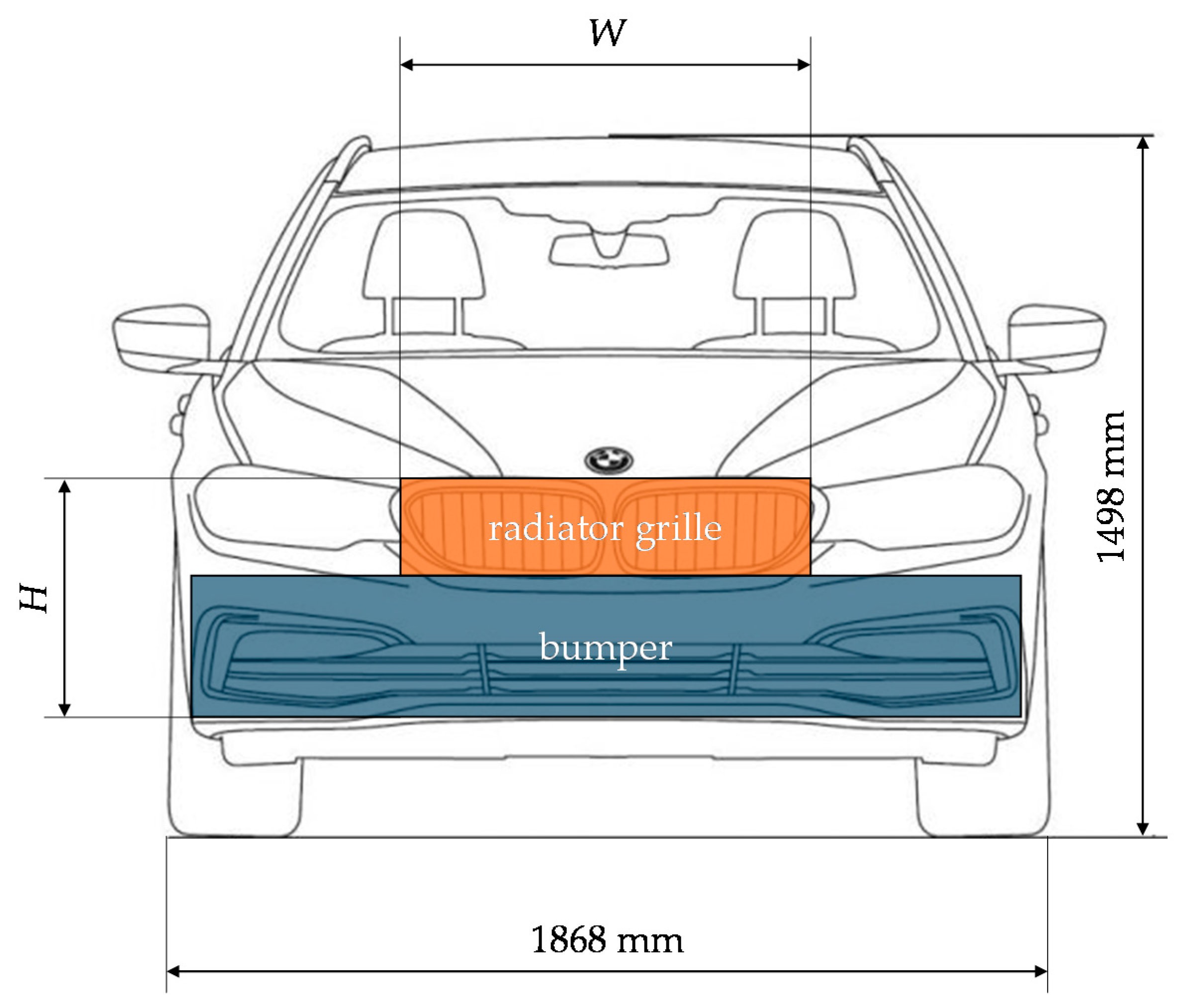
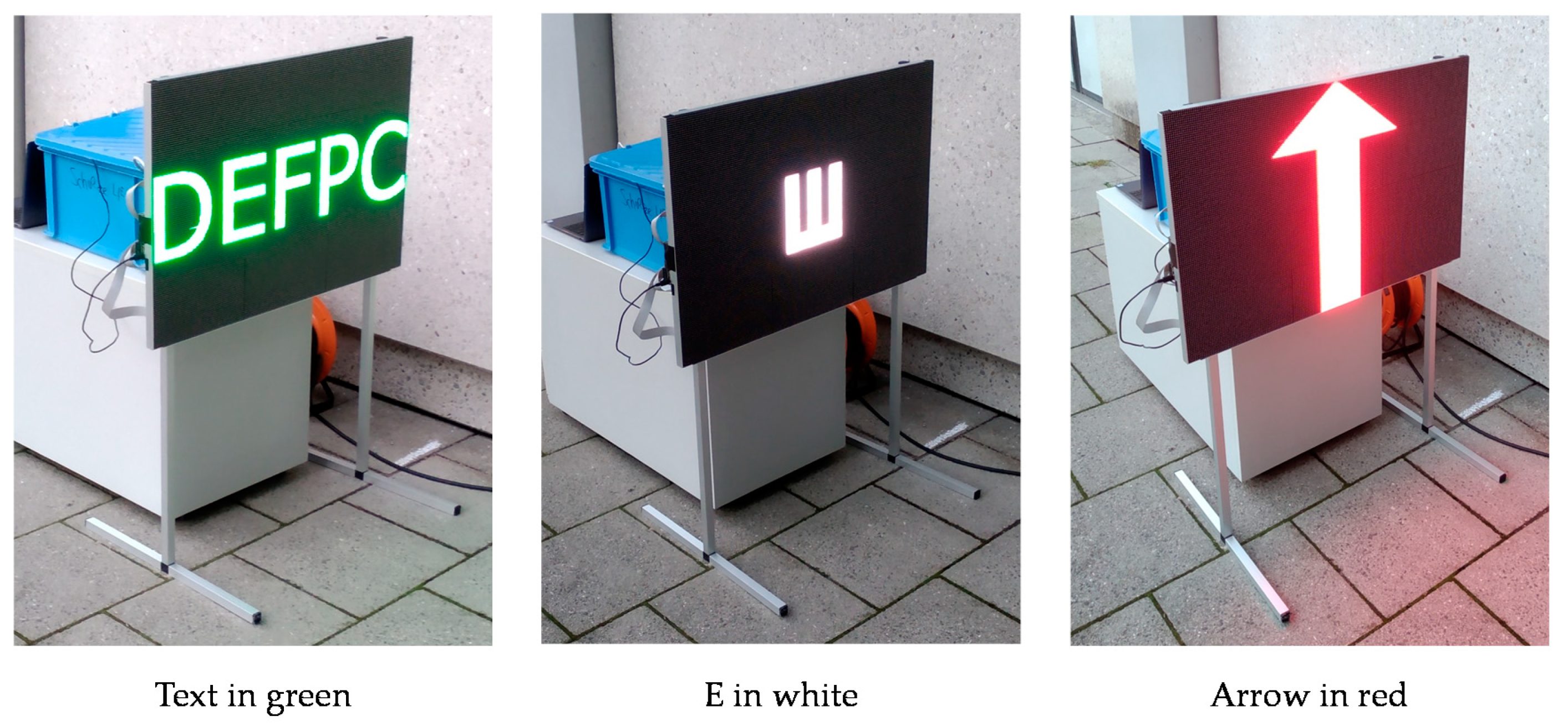

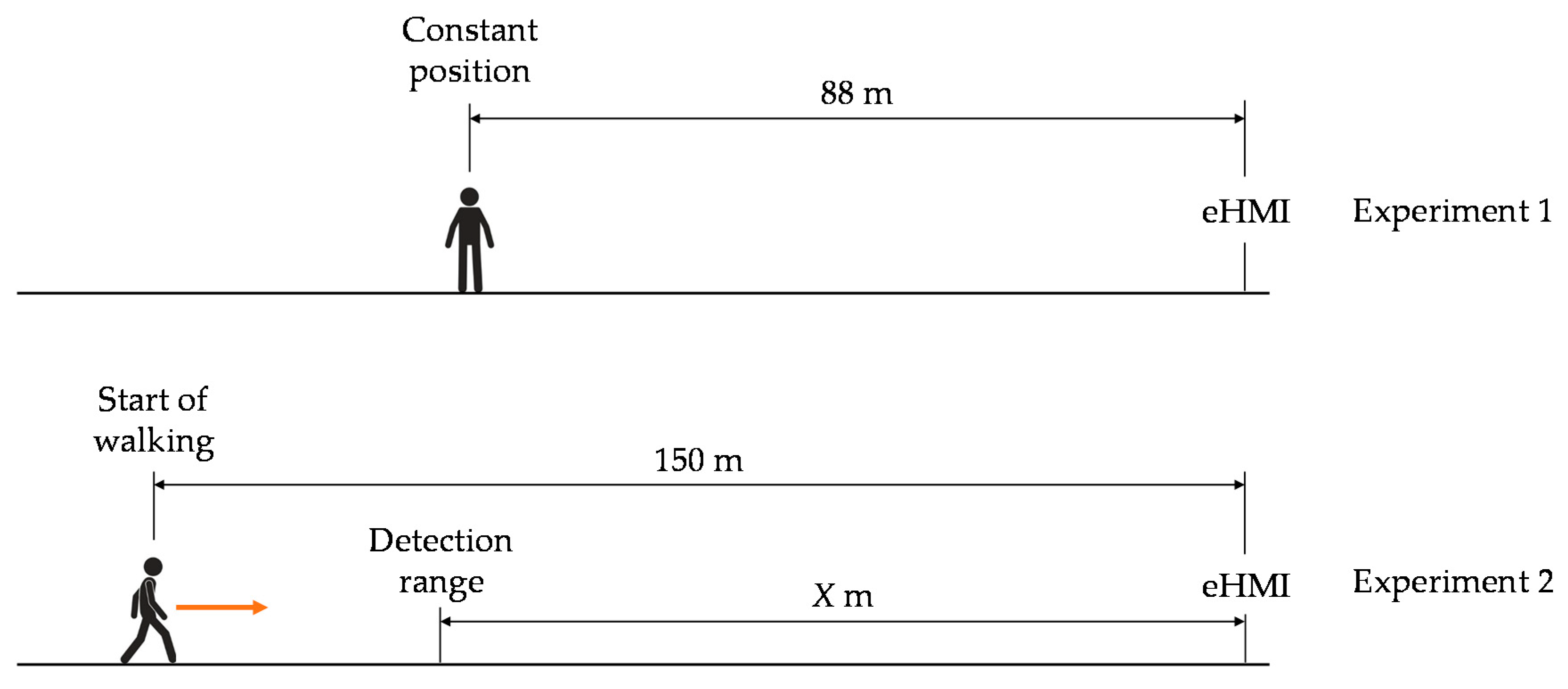

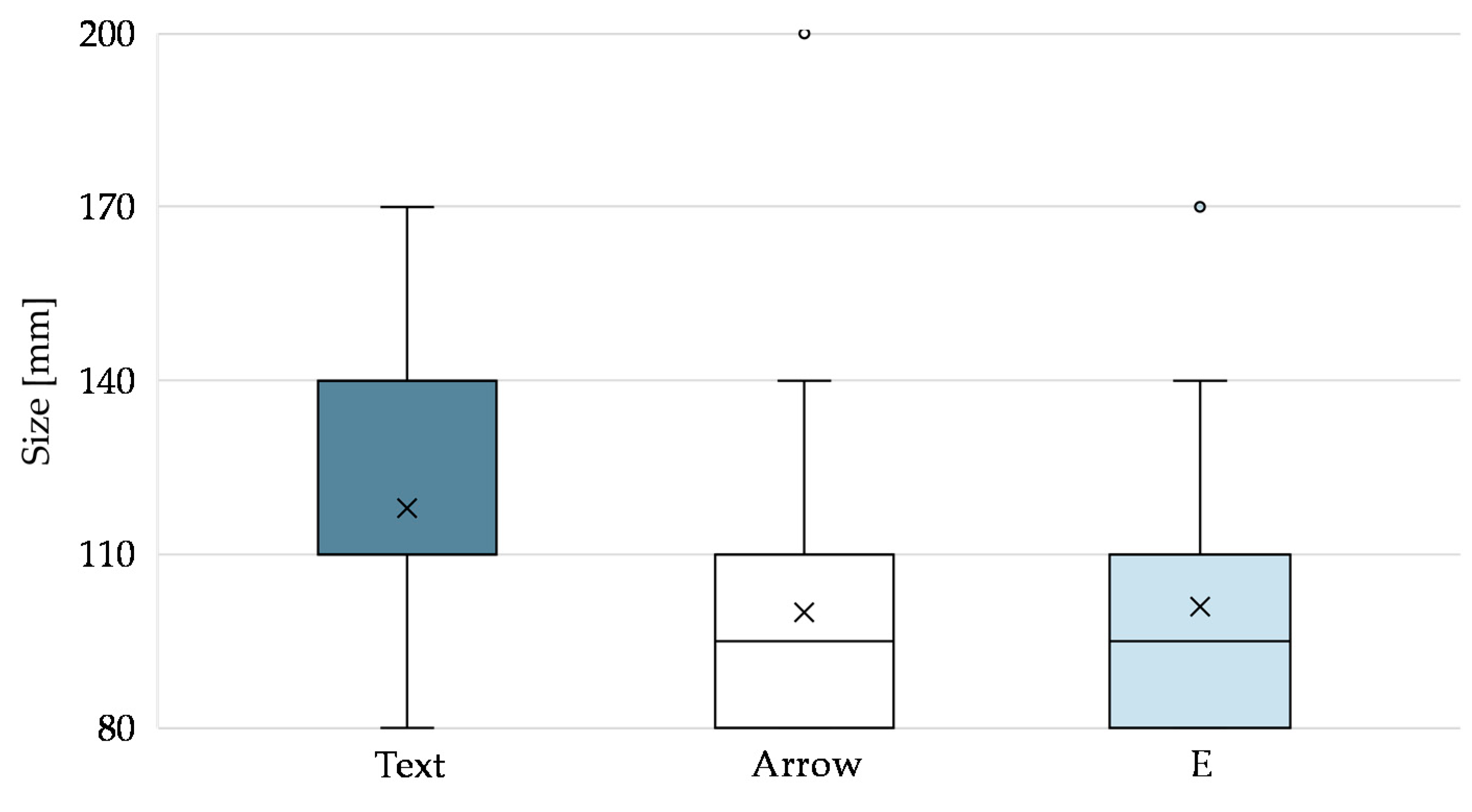
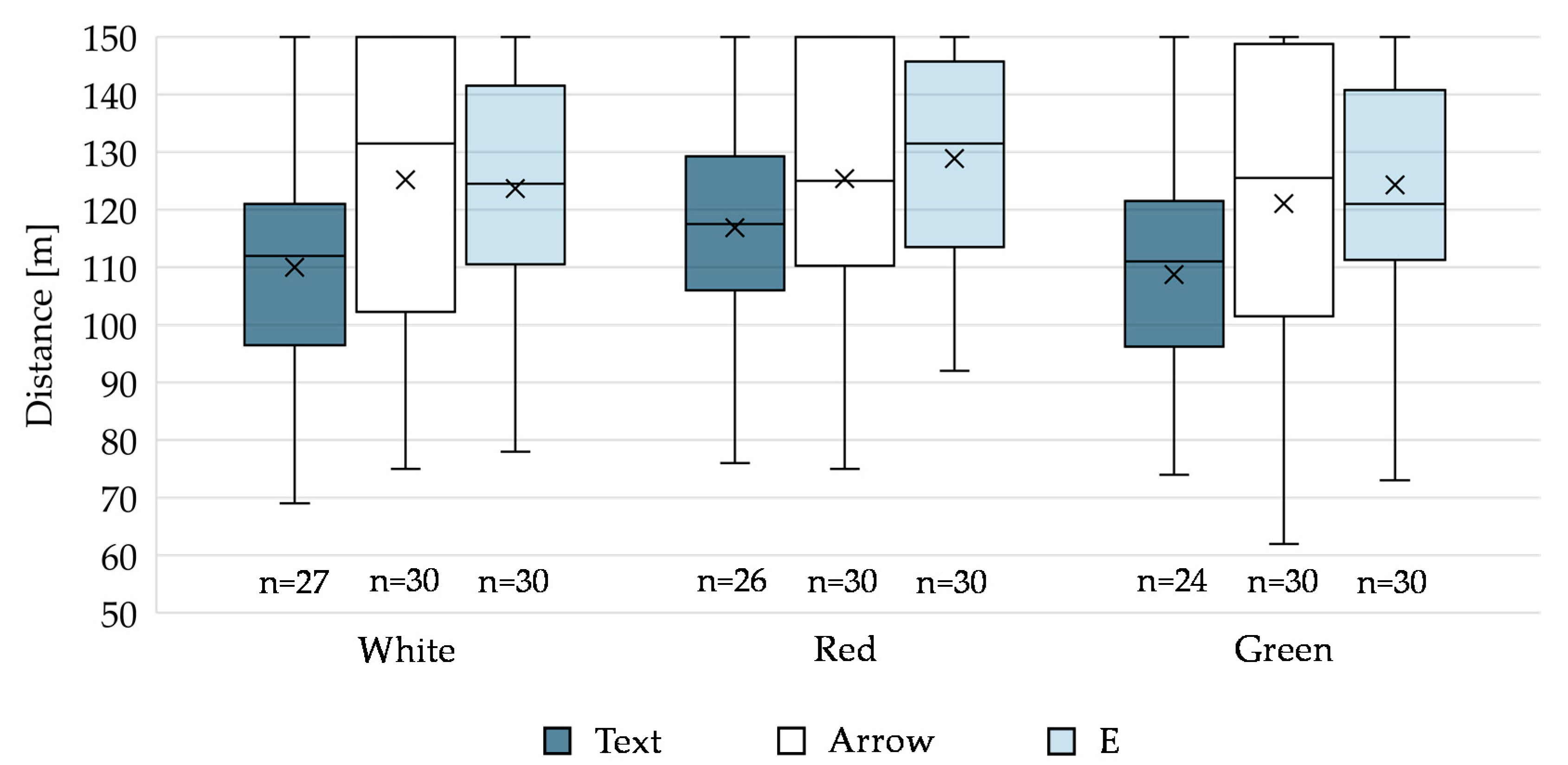
| Size (mm) | 80 | 110 | 140 | 170 | 200 | 230 |
| Distance (m) | 13.75 | 18.91 | 24.06 | 29.22 | 34.38 | 39.53 |
| Item | 5-Point Likert Scale | |
|---|---|---|
| Legibility: | Please rate the legibility of the displayed text (symbol). | Very poor to very good |
| Concentration: | Please rate the degree of concentration required to read (identify) the text (symbol). | Very high to very low |
| Confidence: | How sure are you that you have read (identified) the text (symbol) correctly? | Very unsure to very sure |
| Size (mm) | ||||||
|---|---|---|---|---|---|---|
| 230 | 200 | 170 | 140 | 110 | 80 | |
| Text | - | 30 (100%) | 30 (100%) | 28 (93%) | 20 (67%) | 4 (13%) |
| Arrow | 30 (100%) | 30 (100%) | 29 (97%) | 29 (97%) | 27 (90%) | 16 (53%) |
| E | 30 (100%) | 30 (100%) | 30 (100%) | 29 (97%) | 26 (87%) | 15 (50%) |
| W | p | r | ||
|---|---|---|---|---|
| Text | Arrow | 29.00 | 0.006 | 0.695 |
| Text | E | 27.00 | 0.002 | 0.743 |
| Arrow | E | 43.00 | 0.884 | 0.055 |
| Size (mm) | ||||||
|---|---|---|---|---|---|---|
| 230 | 200 | 170 | 140 | 110 | 80 | |
| Legibility: | Please rate the legibility of the displayed text (symbol). (1 = very poor, 5 = very good) | |||||
| Text | - | 5 | 4 | 3.5 | 2 | 1 |
| Arrow | 4 | 4 | 3.5 | 3 | 2 | 1 |
| E | 5 | 5 | 4 | 3 | 2 | 1 |
| Concentration: | Please rate the degree of concentration required to read (identify) the text (symbol). (1 = very high, 5 = very low) | |||||
| Text | - | 4 | 4 | 3 | 2 | 1 |
| Arrow | 4 | 4 | 3 | 3 | 2 | 1 |
| E | 5 | 4 | 4 | 3 | 2 | 1 |
| Confidence: | How sure are you that you have read (identified) the text (symbol) correctly? (1 = very unsure, 5 = very sure) | |||||
| Text | - | 5 | 5 | 4 | 2 | 1 |
| Arrow | 5 | 5 | 4 | 4 | 3 | 1 |
| E | 5 | 5 | 5 | 4 | 2.5 | 1 |
| White | Red | Green | |
|---|---|---|---|
| Text, M (SD) | 110.04 m (20.84 m), n = 27 | 116.85 m (19.96 m), n = 26 | 108.71 m (18.93 m), n = 24 |
| Arrow, M (SD) | 125.17 m (24.71 m), n = 30 | 125.37 m (23.14 m), n = 30 | 121.03 m (26.04 m), n = 30 |
| E, M (SD) | 123.70 m (20.61 m), n = 30 | 128.90 m (19.15 m), n = 30 | 124.30 m (20.81 m), n = 30 |
| F | df | p | ||
|---|---|---|---|---|
| White (n = 27) | 10.704 | 2, 52 | <0.001 | 0.292 |
| Red (n = 26) | 5.713 | 2, 50 | 0.006 | 0.186 |
| Green (n = 24) | 19.267 | 2, 46 | <0.001 | 0.456 |
| pbonf | Cohen’s d | ||
|---|---|---|---|
| White | |||
| Text | Arrow | 0.003 | 0.707 |
| Text | E | <0.001 | 0.854 |
| Arrow | E | 1.000 | 0.034 |
| Red | |||
| Text | Arrow | 0.086 | 0.456 |
| Text | E | 0.007 | 0.666 |
| Arrow | E | 0.841 | 0.216 |
| Green | |||
| Text | Arrow | 0.009 | 0.677 |
| Text | E | <0.001 | 1.306 |
| Arrow | E | 0.035 | 0.558 |
| F | df | p | ||
|---|---|---|---|---|
| Text (n = 21) | 5.859 | 2, 40 | 0.006 | 0.227 |
| Arrow (n = 30) | 1.145 | 2, 58 | 0.325 | 0.038 |
| E (n = 30) | 1.943 | 2, 58 | 0.152 | 0.063 |
| pbonf | Cohen’s d | ||
|---|---|---|---|
| White | Red | 0.046 | 0.579 |
| White | Green | 1.000 | 0.097 |
| Red | Green | 0.006 | 0.770 |
© 2020 by the authors. Licensee MDPI, Basel, Switzerland. This article is an open access article distributed under the terms and conditions of the Creative Commons Attribution (CC BY) license (http://creativecommons.org/licenses/by/4.0/).
Share and Cite
Rettenmaier, M.; Schulze, J.; Bengler, K. How Much Space Is Required? Effect of Distance, Content, and Color on External Human–Machine Interface Size. Information 2020, 11, 346. https://doi.org/10.3390/info11070346
Rettenmaier M, Schulze J, Bengler K. How Much Space Is Required? Effect of Distance, Content, and Color on External Human–Machine Interface Size. Information. 2020; 11(7):346. https://doi.org/10.3390/info11070346
Chicago/Turabian StyleRettenmaier, Michael, Jonas Schulze, and Klaus Bengler. 2020. "How Much Space Is Required? Effect of Distance, Content, and Color on External Human–Machine Interface Size" Information 11, no. 7: 346. https://doi.org/10.3390/info11070346
APA StyleRettenmaier, M., Schulze, J., & Bengler, K. (2020). How Much Space Is Required? Effect of Distance, Content, and Color on External Human–Machine Interface Size. Information, 11(7), 346. https://doi.org/10.3390/info11070346





